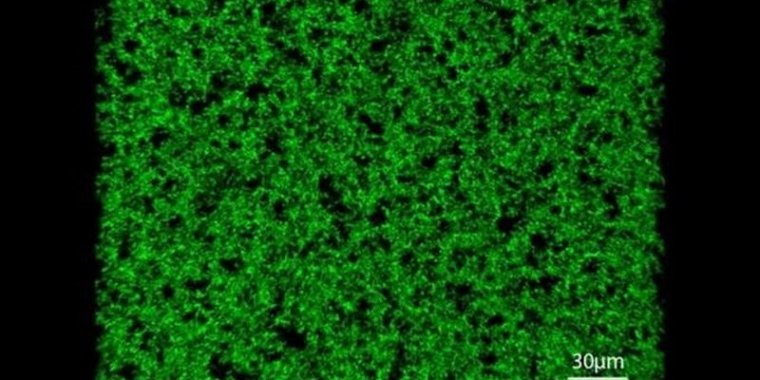| News / Science News |
Biomaterial Artificial Protein Helps Heal Tissue
Biomedical engineers from Duke University and Washington University in St. Louis have demonstrated that, by injecting an artificial protein made from a solution of ordered and disordered segments, a solid scaffold forms in response to body heat, and in a few weeks seamlessly integrates into tissue.

Biomaterial artificial protein helps heal tissue. ![]()
Proteins function by folding, origami-like, and interacting with specific biomolecular structures. Researchers previously believed that proteins needed a fixed shape to function, but over the last two decades there has been a growing interest in intrinsically disordered proteins (IDPs).
Unlike their well-folded counterparts, IDPs can adopt a plethora of distinct structures. However, these structural preferences are non-random, and recent advances have shown that there are well-defined rules that connect information in the amino acid sequences of IDPs to the collections of structures they can adopt.
Researchers have hypothesized that versatility in protein function is achievable by stringing together well-folded proteins with IDPs—rather like pearl necklaces.
This versatility is obvious in biological materials like muscle and silk fibers, which are made of proteins that combine ordered and disordered regions, enabling the materials to exhibit characteristics like elasticity of rubber and the mechanical strength of steel.
IDPs are instrumental to cellular function, and many biomedical engineers have concentrated their efforts on an extremely useful IDP called elastin.
A highly elastic protein found throughout the body, elastin allows blood vessels and organs—like the skin, uterus and lungs—to return to their original shape after being stretched or compressed. However, creating the elastin outside the body proved to be a challenge.
The research team worked with elastin-like polypeptides (ELPs), which are fully disordered proteins made to mimic pieces of elastin. ELPs are useful biomaterials because they can undergo phase changes—go from a soluble to an insoluble state, or vice-versa—in response to changes in temperature.
But by adding ordered domains to the ELPs, they created "Frankenstein" proteins that combine ordered domains and disordered regions leading to so-called partially ordered proteins (POPs), which are equipped with the structural stability of ordered proteins without losing the ELPs ability to become liquid or solid via temperature changes.
Designed as a fluid at room temperature that solidifies at body temperature, these new biomaterials form a stable, porous scaffold when injected that rapidly integrates into the surrounding tissue with minimal inflammation and promotes the formation of blood vessels.
Although the scaffold created by the POP was stable, the team also observed that the material would completely re-dissolve once it was cooled. What's more, the formation and dissolution temperatures could be independently controlled by controlling the ratios of disordered and ordered segments in the biomaterial.
This independent tunability confers shape memories on the POPs via a phenomenon known as hysteresis, allowing them to return to their original shape after a temperature cue.
Moving ahead, the team hopes to study the material in animal models to examine potential uses in tissue engineering and wound healing and to develop a better understanding of why the material promotes vascularization. (Tasnim News Agency)
YOU MAY ALSO LIKE



